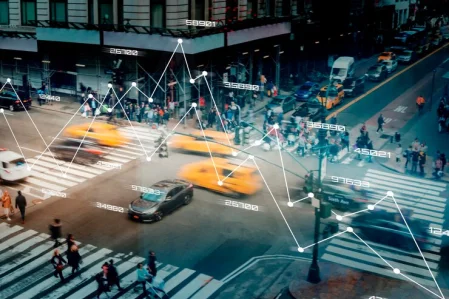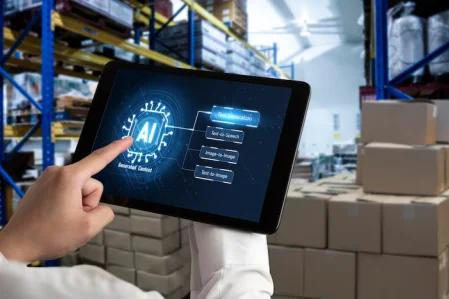Warehouses are no longer just large buildings filled with racks and forklifts — today, they act as the main hubs that keep global supply chains running smoothly. And the foundation of this change is in AI in Warehouse Management and AI Integration Services in warehousing operations. From forecasting demand before it occurs to making sure shelves are filled with the right products at the right time, AI is transforming traditional warehouses into smart, self-optimising entities.
But the impact isn’t merely theoretical; it can be measured. According to a recent report from McKinsey, AI has the potential to reduce logistics costs by 5–20% and inventories by 20–30%. Think about what that means for a company: quicker deliveries, fewer errors, and millions saved in operating expenses.
In this blog, we’ll take a deep dive into how AI is transforming warehouse management, looking at examples of what’s already being seen on the ground and how AI is directly impacting the warehousing sector, what AI can do for warehousing, and what the future warehouse using AI looks like.
Challenges In Warehouse Management
Warehouses are the heart of the supply chain, but traditional management techniques will often miss the mark when it comes to today’s dynamic and complex environment. Unmanned, poor visibility, and increased labor costs contribute to a reduction in efficiency, accuracy, and customer satisfaction. Here are some of the biggest challenges that businesses must come to terms with in warehouse management today:
1. Inefficiency and Delays
When staff are manually picking items, scanning barcodes, or updating records, time is wasted. Workers can spend as much as 50% of their day just walking between shelves instead of actively picking or packing. When volume is peaking, the inefficiencies create bottlenecks, slow order turnaround times, and unhappy customers. Older techniques are also not agile enough to rapidly respond to spikes in volume.
2. Errors and Inaccuracies
Human intervention in redundant tasks invites error in the form of mislabeling, mis-picking, or miscounting inventory. Just a few percentage points of errors can reverberate throughout the supply chain, leading to expensive returns, shipping delays, or customer churn. It’s tough to keep track of everything in an old-school paper-based or spreadsheet-based inventory system of records, even if you don’t have a warehouse filled to the brim with thousands of SKUs.
3. Labor Shortages and Rising Costs
The warehousing industry has been coping with a global labor shortage for years. High employee turnover, physically demanding jobs, and the cyclicality of demand create staffing challenges. Meanwhile, tight margins are compounded by increasing labor costs. This disparity often turns warehouses into “a revolving door” for new hires and training at an extra cost that doesn’t result in added efficiency.
4. Scant Visibility and Lack of Insights into Data
In traditional warehouses, it is not unusual for managers to struggle with what’s known as “dark inventory” — product that is there, but not tracked or tracked in real time. Managers count on cyclic counts that require a lot of labor and are subject to counting errors, thus not knowing which goods are really in stock. This lack of visibility results in either overstocking (capital tied up in unsold goods) or stockouts (lost sales and unhappy customers). Without accurate real-time information, warehouses are only able to respond to issues rather than predict them.
5. Limited Scalability
Outdated warehouse management systems (WMS) and manual processes mean that you’re unable to scale in response to peak or seasonal demands or new business. An employer can always temporarily paper over that kind of shortfall by hiring more workers, but at some point, the costs escalate and the returns diminish. As e-commerce flourishes, old-fashioned warehouses are challenged to keep up with next- or same-day delivery requests.
Key Applications Of AI In Warehouse Management
Artificial intelligence isn’t just another buzzword in logistics anymore — it’s taking root in warehouse management, and laying the future for success. AI-driven solutions, ranging from robotics to predictive analytics in supply chain and computer vision, are rendering operations quicker, safer, and more productive. Those technologies are enabling companies to cut costs, boost precision, and build more resilient supply chains.

The following are the major applications of AI in warehousing and how they are transforming the logistics industry:
1. Robotics and Automation
Robots incorporating AI (including AMRs, AGVs, and robotic arms) are being used to undertake activities including pallet moving, order picking, and stock replenishment. These bots have computer vision and AI-based navigation systems that can see and move safely around humans and other obstacles.In parallel, Robotic Process Automation (RPA) is streamlining digital tasks like order processing and inventory updates.
For instance, Amazon has more than 750,000 mobile robots and robotic arms in its fulfillment centers. Such robots speed up and ensure accuracy by eliminating human traffic and running distances. And they cut down on workplace injuries by sharing their heavy or repetitive labor. In the real world, Walmart’s new Canadian automated fulfillment center uses GreyOrange robots to handle 20 million items annually and to reach 61% of Canadian households with two-day shipping.
2. Predictive Analytics & Forecasting
AI systems can also analyse historical sales, market trends, and other variables to predict demand and maximise inventory. With machine learning, models can forecast what will be sold and how many items, in many cases, doing this about 30 percent more accurately than traditional methods. This makes it possible to maintain adequate inventory levels – neither experiencing heavy carrying costs for overstock, nor missing revenue due to stockouts.
AI-enabled inventory management systems do this by automatically updating reorder points and dynamically slotting fast-moving goods closer to the dispatch area, which ultimately helps to cut down picking time. Oracle also highlights inventory management, order fulfillment, and forecasting as among the key areas in which AI increases the accuracy and efficiency of warehousing.
3. Computer Vision & Real-Time Tracking
AI-powered cameras and sensors detect products, check inventory levels, and track assets. For instance, drones or ceiling cameras can scan barcodes and count pallets during off-hours. AI vision systems can immediately catch picking errors (e.g., incorrect items in a carton) before shipping them. Whether in cold storage or pharma, computer vision can ensure package integrity or read data plates without human inspection. Combined with RFID and IoT sensors, AI offers real-time visibility over product location and status, facilitating close integration of the supply chain.
4. Smart Inventory Systems
The warehouses of the future are “intelligent.” They include AI for self-driving task assignment and layout optimization, and the leanness of operation.
For example, AI can suggest dynamic slotting, consistent reordering of which products sit in which bin based on seasonality and order patterns. In receiving or return scenarios, AI can also extract order details from invoices via OCR/ML, minimizing manual data entry. 3dlogistix says that warehouses leveraging AI for inventory are experiencing pick rate increases of 20-40% and holding cost decreases of 15- 25%.
Benefits Of AI In Warehouse Management
The rise of Artificial Intelligence (AI) in logistics and supply chains is making warehouses smarter, faster, and more sustainable. AI is helping companies increase efficiency, reduce costs, and drive accuracy across various applications, including robotics, predictive analytics, computer vision, and automation.
Here’s an overview of the main advantages of AI in warehouse management that are fueling this change:
1. Increased productivity
Robots and AI assistants help with picking, packing, and restocking. For instance, DHL’s implementation of Locus Robotics AMRs resulted in a 2-fold increase in picker productivity and enabled 500M+ robot-assisted picks by 2024. Predictive analytics can also dynamically route tasks so that workers don’t have to walk from pick to pick. Overall throughput increases significantly; one analysis notes AI-driven warehouses can achieve 20-40% faster pick rates than manual operations.

2. Cost-efficiency
AI offers several ways to deliver cost savings. Robotic systems operate 24 hours a day, 7 days a week, without fatigue, resulting in decreased overtime and reduced error-based waste. Prediction algorithms can shave inventory carrying costs by preventing overstock (AI can lower holding costs by about 15–25%). Route optimization and delivery planning conserve fuel (typically a 10–20% reduction in plying costs. In another, automating robotics in logistics is estimated to save $10 billion annually by 2030.
3. Higher accuracy
Computer vision and AI algorithms help eradicate human errors. In one trial at DHL, the introduction of robotics led to a 50% reduction in picking errors and a 60% fall in order cycle time. AI can also help to identify anomalies (the wrong item, a damaged good, a mis-scanned barcode) before the order ships, which can increase customer satisfaction. According to Oracle, AI-enabled slotting and vision systems improve order accuracy and reduce the risk of late or incorrect shipments.
4. Efficient Labor Usage
More efficient use of labor: Instead of simply replacing workers, AI and automation free employees to concentrate on higher-value tasks. Cobots (for collaborative robots) are used to lift heavy items and scan shelves, while human employees are deployed to check for quality and handle exceptions. For instance, DHL’s AMRs transport totes to static pickers, cutting walking distance and alleviating fatigue. This hybrid solution allows workers to work, but keeps them safer and more productive
5. Sustainability and compliance
AI assists in energy conservation and waste minimization. Intelligent systems can add more energy-intensive jobs (for instance, refrigeration or conveyors) during off-peak hours. Digital monitoring provides FIFO (first-in-first-out) rotation of perishables to reduce spoilage. Oracle says AI can contribute to sustainability efforts in warehousing, such as by minimizing waste and energy use.
6. Scalability and flexibility
AI allows warehouses to scale up more easily during peak seasons.DHL, by using a Robotics-as-a-Service model (rent robots), could add hundreds of robots to accommodate holiday peak needs without a huge capital outlay. AI systems are also adaptable: machine learning models are always learning from new data, and they process seasonal spikes or new products just fine over time.
Quick Read: AI In Logistics
Conclusion
AI in warehousing management is not a futuristic thing anymore, but a game-changer in the warehouse management space of today. Solving years-old problems of inefficiencies, labor shortages, mistakes, and lack of scalability, AI-enabled solutions will turn warehouses into intelligent self-optimizing nodes of the supply chain. Whether robotics, predictive analytics, or computer vision, intelligent AI capabilities ultimately increase productivity, drive down costs, improve accuracy, support sustainability objectives, and offer much-needed flexibility to deal with future influxes. Businesses that adopt AI for warehouse management are not only optimising logistics, they are setting the foundation for robust, scalable, and environmentally sustainable supply chains of the future.


 Healthcare App Development Services
Healthcare App Development Services
 Real Estate Web Development Services
Real Estate Web Development Services
 E-Commerce App Development Services
E-Commerce App Development Services E-Commerce Web Development Services
E-Commerce Web Development Services Blockchain E-commerce Development Company
Blockchain E-commerce Development Company
 Fintech App Development Services
Fintech App Development Services Fintech Web Development
Fintech Web Development Blockchain Fintech Development Company
Blockchain Fintech Development Company
 E-Learning App Development Services
E-Learning App Development Services
 Restaurant App Development Company
Restaurant App Development Company
 Mobile Game Development Company
Mobile Game Development Company
 Travel App Development Company
Travel App Development Company
 Automotive Web Design
Automotive Web Design
 AI Traffic Management System
AI Traffic Management System
 AI Inventory Management Software
AI Inventory Management Software
 AI Software Development
AI Software Development  AI Development Company
AI Development Company  AI App Development Services
AI App Development Services  ChatGPT integration services
ChatGPT integration services  AI Integration Services
AI Integration Services  Generative AI Development Services
Generative AI Development Services  Natural Language Processing Company
Natural Language Processing Company Machine Learning Development
Machine Learning Development  Machine learning consulting services
Machine learning consulting services  Blockchain Development
Blockchain Development  Blockchain Software Development
Blockchain Software Development  Smart Contract Development Company
Smart Contract Development Company  NFT Marketplace Development Services
NFT Marketplace Development Services  Asset Tokenization Company
Asset Tokenization Company DeFi Wallet Development Company
DeFi Wallet Development Company Mobile App Development
Mobile App Development  IOS App Development
IOS App Development  Android App Development
Android App Development  Cross-Platform App Development
Cross-Platform App Development  Augmented Reality (AR) App Development
Augmented Reality (AR) App Development  Virtual Reality (VR) App Development
Virtual Reality (VR) App Development  Web App Development
Web App Development  SaaS App Development
SaaS App Development Flutter
Flutter  React Native
React Native  Swift (IOS)
Swift (IOS)  Kotlin (Android)
Kotlin (Android)  Mean Stack Development
Mean Stack Development  AngularJS Development
AngularJS Development  MongoDB Development
MongoDB Development  Nodejs Development
Nodejs Development  Database Development
Database Development Ruby on Rails Development
Ruby on Rails Development Expressjs Development
Expressjs Development  Full Stack Development
Full Stack Development  Web Development Services
Web Development Services  Laravel Development
Laravel Development  LAMP Development
LAMP Development  Custom PHP Development
Custom PHP Development  .Net Development
.Net Development  User Experience Design Services
User Experience Design Services  User Interface Design Services
User Interface Design Services  Automated Testing
Automated Testing  Manual Testing
Manual Testing  Digital Marketing Services
Digital Marketing Services 
 Ride-Sharing And Taxi Services
Ride-Sharing And Taxi Services Food Delivery Services
Food Delivery Services Grocery Delivery Services
Grocery Delivery Services Transportation And Logistics
Transportation And Logistics Car Wash App
Car Wash App Home Services App
Home Services App ERP Development Services
ERP Development Services CMS Development Services
CMS Development Services LMS Development
LMS Development CRM Development
CRM Development DevOps Development Services
DevOps Development Services AI Business Solutions
AI Business Solutions AI Cloud Solutions
AI Cloud Solutions AI Chatbot Development
AI Chatbot Development API Development
API Development Blockchain Product Development
Blockchain Product Development Cryptocurrency Wallet Development
Cryptocurrency Wallet Development About Talentelgia
About Talentelgia  Our Team
Our Team  Our Culture
Our Culture 
 Healthcare App Development Services
Healthcare App Development Services Real Estate Web Development Services
Real Estate Web Development Services E-Commerce App Development Services
E-Commerce App Development Services E-Commerce Web Development Services
E-Commerce Web Development Services Blockchain E-commerce
Development Company
Blockchain E-commerce
Development Company Fintech App Development Services
Fintech App Development Services Finance Web Development
Finance Web Development Blockchain Fintech
Development Company
Blockchain Fintech
Development Company E-Learning App Development Services
E-Learning App Development Services Restaurant App Development Company
Restaurant App Development Company Mobile Game Development Company
Mobile Game Development Company Travel App Development Company
Travel App Development Company Automotive Web Design
Automotive Web Design AI Traffic Management System
AI Traffic Management System AI Inventory Management Software
AI Inventory Management Software AI Software Development
AI Software Development AI Development Company
AI Development Company ChatGPT integration services
ChatGPT integration services AI Integration Services
AI Integration Services Machine Learning Development
Machine Learning Development Machine learning consulting services
Machine learning consulting services Blockchain Development
Blockchain Development Blockchain Software Development
Blockchain Software Development Smart contract development company
Smart contract development company NFT marketplace development services
NFT marketplace development services IOS App Development
IOS App Development Android App Development
Android App Development Cross-Platform App Development
Cross-Platform App Development Augmented Reality (AR) App
Development
Augmented Reality (AR) App
Development Virtual Reality (VR) App Development
Virtual Reality (VR) App Development Web App Development
Web App Development Flutter
Flutter React
Native
React
Native Swift
(IOS)
Swift
(IOS) Kotlin (Android)
Kotlin (Android) MEAN Stack Development
MEAN Stack Development AngularJS Development
AngularJS Development MongoDB Development
MongoDB Development Nodejs Development
Nodejs Development Database development services
Database development services Ruby on Rails Development services
Ruby on Rails Development services Expressjs Development
Expressjs Development Full Stack Development
Full Stack Development Web Development Services
Web Development Services Laravel Development
Laravel Development LAMP
Development
LAMP
Development Custom PHP Development
Custom PHP Development User Experience Design Services
User Experience Design Services User Interface Design Services
User Interface Design Services Automated Testing
Automated Testing Manual
Testing
Manual
Testing About Talentelgia
About Talentelgia Our Team
Our Team Our Culture
Our Culture

















 Write us on:
Write us on:  Business queries:
Business queries:  HR:
HR: 




